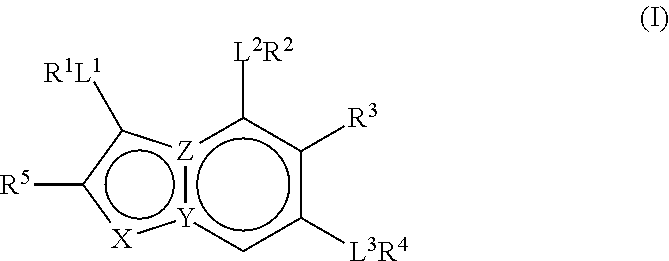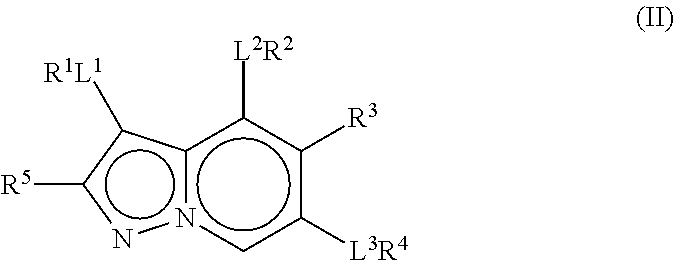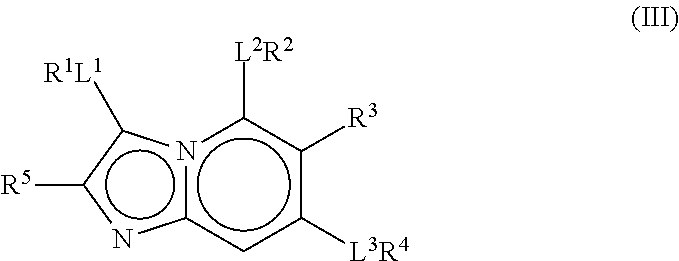Therapeutic compounds
a technology of imidazopyridine and pyrazolopyridine, which is applied in the field of pyrazolopyridines and imidazopyridines, can solve the problems of poor prognosis and metastasis, aggressive tumor behavior, and high trk expression
- Summary
- Abstract
- Description
- Claims
- Application Information
AI Technical Summary
Benefits of technology
Problems solved by technology
Method used
Image
Examples
examples 2
Representative Compounds 2-1 to 2-36
Compound 2-1
3-iodo-4-methoxy-6-(1-methyl-1H-pyrazol-4-yl)pyrazolo[1,5-a]pyridine)
[0794]
Step 1: 4-methoxy-6-(1-methyl-1H-pyrazol-4-yl)pyrazolo[1,5-a]pyridine)
[0795]Method A: 6-bromo-4-methoxypyrazolo[1,5-a]pyridine (500 mg, 2.20 mmol), 1-methyl-4-(4,4,5,5-tetramethyl-1,3,2-dioxaborolan-2-yl)-1H-pyrazole (1375 mg, 6.61 mmol), tetrakis(triphenylphosphine)palladium (0) (254 mg, 0.220 mmol), and sodium carbonate (700 mg, 6.61 mmol) were suspended in a mixture of 1,4-dioxane (19.8 ml) and water (2.2 ml). The mixture was sparged with argon for 10 minutes, then heated to 90° C. After 2 h, the reaction mixture was diluted in ethyl acetate, washed with saturated aqueous sodium hydrogen carbonate and brine then dried over sodium sulfate, filtered and concentrated. The residue was purified by column chromatography on silica gel (methanol / ethyl acetate gradient) to give 4-methoxy-6-(1-methyl-1H-pyrazol-4-yl)pyrazolo[1,5-a]pyridine as a tan solid contaminated w...
examples 3
Representative Compounds 3-1 to 3-14 and 3-23 to 3-135, and Preparative Compounds 3-15 to 3-22
Compound 3-1
4-methoxy-6-(1-methyl-1H-pyrazol-4-yl)-3-(pyridin-3-ylethynyl)pyrazolo[1,5-a]pyridine
[0822]
[0823]3-iodo-4-methoxy-6-(1-methyl-1H-pyrazol-4-yl)pyrazolo[1,5-a]pyridine (20.0 mg, 0.056 mmol), 3-ethynylpyridine (17.5 mg, 0.169 mmol), tetrakis(triphenylphosphine)palladium (0) (6.5 mg, 5.7 mmol), and copper (I) iodide (6.5 mg, 0.034 mmol) were suspended in DMF (1 ml). Triethylamine (0.016 ml, 0.113 mmol) was added, the mixture was sparged with argon for 10 minutes then allowed to stir at ambient temperature. After 1 h, the reaction mixture was diluted in ethyl acetate, washed with saturated aqueous sodium hydrogen carbonate and brine then dried over sodium sulfate, filtered and concentrated. The residue was purified by preparative HPLC Reverse phase (C-18), eluting with Acetonitrile / Water+0.05% TFA. The fractions containing product were combined and diluted in ethyl acetate, then wash...
examples 4
Representative Compounds 4-1, 4-2 and 4-4 to 4-31, and Preparative Compound 4-3
Compound 4-1
3-(2,7-diazaspiro[3.5]non-2-ylmethyl)-4-methoxy-6-(1-methyl-1H-pyrazol-4-yl)pyrazolo[1,5-a]pyridine
[0951]
Step 1: tert-butyl 2-{[4-methoxy-6-(1-methyl-1H-pyrazol-4-yl)pyrazolo[1,5-a]pyridin-3-yl]methyl}-2,7-diazaspiro[3.5]nonane-7-carboxylate)
[0952]To a solution of 4-methoxy-6-(1-methyl-1H-pyrazol-4-yl)pyrazolo[1,5-a]pyridine-3-carbaldehyde (25.0 mg, 0.098 mmol), 7-(tert-butoxycarbonyl)-7-aza-2-azoniaspiro[3.5]nonane chloride (39.0 mg, 0.15 mmol), and triethylamine (0.054 mL, 0.39 mmol) in 1,2-dichloroethane (2 ml) was added sodium triacetoxyborohydride (41.0 mg, 0.20 mmol). After 2 h, the reaction was quenched with saturated aqueous sodium hydrogen carbonate, diluted with ethyl acetate, dried over magnesium sulfate, filtered and concentrated. The residue was purified by column chromatography on silica gel (ethyl acetate / isohexane gradient) to give tert-butyl 2-{[4-methoxy-6-(1-methyl-1H-pyrazo...
PUM
| Property | Measurement | Unit |
|---|---|---|
| concentration | aaaaa | aaaaa |
| MW | aaaaa | aaaaa |
| pH | aaaaa | aaaaa |
Abstract
Description
Claims
Application Information
 Login to View More
Login to View More - R&D
- Intellectual Property
- Life Sciences
- Materials
- Tech Scout
- Unparalleled Data Quality
- Higher Quality Content
- 60% Fewer Hallucinations
Browse by: Latest US Patents, China's latest patents, Technical Efficacy Thesaurus, Application Domain, Technology Topic, Popular Technical Reports.
© 2025 PatSnap. All rights reserved.Legal|Privacy policy|Modern Slavery Act Transparency Statement|Sitemap|About US| Contact US: help@patsnap.com



